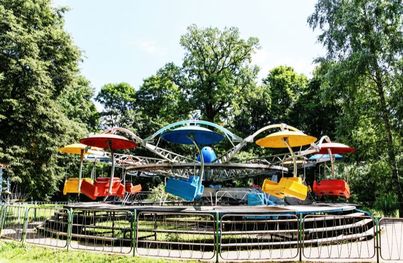Vytautas park
|
Already during the Russian Empire times, it was planned to create a park with a stage and swings on this hill. The official opening took place in 1872, and the park was given the name of Petrovka - in honour of tsar Peter The Great.
In 1919, after Lithuania had gained the Independence, the name was changed into Vytautas park after Vytautas The Great. Vytautas park used to be one of the most outstanding recreation places in Kaunas, with tennis courts and football pitches. The Lithuanian Riflemen's Union contributed in the revival of Vytautas park by fixing the central pavillon, the stairs, building the gates to enter from the side of Laisves aleja, Parodos and Vaizganto streets. |
The park was tidied up and planted with flowers. The children could enjoy the company of the inhabitants of the park: rabbits, squirrels, pigeons, pheasants and even a doe. The park used to have its own Theater of the Hill, which premierried a musical about a transatlantic flight of Darius and Girėnas „New-York – Kaunas“.
During the Soviet times, there used to be an amusement park and a freetime center as well. Many cultural events would take place and annually be attended by more that half a million people.
One of the least known secrets of the park are the tunnels, dug during the Nazi occupation period, and never seriously explored. The tunnels are located in between of the stairs, leading towards the amusement park, and the house of Laisvės alėja 2. High-ranked German military officers used to live in there, which causes predictions that the tunnels were meant for the escape from bombing.
Moreover, some remainings of a fortress bunker, built in Tsar’s time, are still left in Vytautas park. After The World War II, it was used as a Smearch weapon warehouse by the special Soviet military units. Eventually, having been abandoned, the building drew the attention of the homeless people and curious teenagers, thus, all the entrance holes were bricked.
During the Soviet times, there used to be an amusement park and a freetime center as well. Many cultural events would take place and annually be attended by more that half a million people.
One of the least known secrets of the park are the tunnels, dug during the Nazi occupation period, and never seriously explored. The tunnels are located in between of the stairs, leading towards the amusement park, and the house of Laisvės alėja 2. High-ranked German military officers used to live in there, which causes predictions that the tunnels were meant for the escape from bombing.
Moreover, some remainings of a fortress bunker, built in Tsar’s time, are still left in Vytautas park. After The World War II, it was used as a Smearch weapon warehouse by the special Soviet military units. Eventually, having been abandoned, the building drew the attention of the homeless people and curious teenagers, thus, all the entrance holes were bricked.

